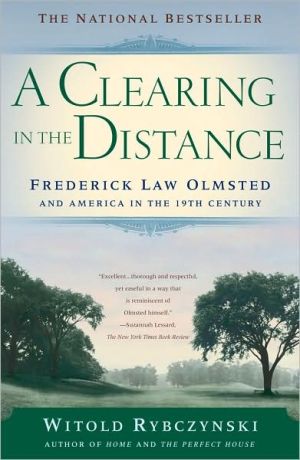A Clearing in the Distance: Frederick Law Olmsted and America in the Nineteenth Century
In a brilliant collaboration between writer and subject, Witold Rybczynski, the bestselling author of Home and City Life, illuminates Frederick Law Olmsted's role as a major cultural figure at the epicenter of nineteenth-century American history.\ We know Olmsted through the physical legacy of his stunning landscapes — among them, New York's Central Park, California's Stanford University campus, and Boston's Back Bay Fens. But Olmsted's contemporaries knew a man of even more extraordinarily...
Search in google:
In a brilliant collaboration between writer and subject, Witold Rybczynski, the bestselling author of Home and City Life, illuminates Frederick Law Olmsted's role as a major cultural figure at the epicenter of nineteenth-century American history. We know Olmsted through the physical legacy of his stunning landscapes -- among them, New York's Central Park, California's Stanford University campus, and Boston's Back Bay Fens. But Olmsted's contemporaries knew a man of even more extraordinarily diverse talents. Born in 1822, he traveled to China on a merchant ship at the age of twenty-one. He cofounded The Nation magazine and was an early voice against slavery. He managed California's largest gold mine and, during the Civil War, served as the executive secretary to the United States Sanitary Commission, the precursor of the Red Cross. Rybczynski's passion for his subject and his understanding of Olmsted's immense complexity and accomplishments make his book a triumphant work. In A Clearing in the Distance, the story of a great nineteenth-century American becomes an intellectual adventure.Andrew Ferguson[Landscaping] really was an art form onceand the life of the man who made it so deserves to be remembered....A Clearing in the Distance is...humanelivelylearned but not pedanticbrief but comprehensive....What better time to rediscover Olmstead and reclaim the patrimony he hoped to leave us? —Fortune
Chapter One: "Tough as Nails"\ With his high forehead, wide-set blue eyes, and unruly hair, the young Frederick Olmsted made a strong impression. A boyhood friend described him as "a vigorous, manly fellow, of medium height, solidly built with rather broad shoulders and a large well formed head. If athletics had been in fashion he would have been high up in foot-ball and base-ball." In midlife he suffered a carriage accident that left him with a pronounced limp, but he remained a skilled small-boat sailor and an experienced horseman. He was a seasoned outdoorsman who hunted and fished, though not for sport. Later photographs usually show him pensive.\ He rarely looks directly at the camera, which gives him an air of self-containment, almost detachment. "His face is generally very placid," wrote his colleague Katharine Wormeley, "with all the expressive delicacy of a woman's, and would be beautiful were it not for an expression which I cannot fathom, — something which is, perhaps, a little too severe about it." But she added, "I think his mouth and smile and the expression of his eyes at times very beautiful...there is a deep, calm thoughtfulness about him which is always attractive and sometimes — provoking."\ An odd choice of word — "provoking." Olmsted's close friend Charles Eliot Norton likewise discerned this quality. "All the lines of his face imply refinement and sensibility to such a degree that it is not till one has looked through them to what is underneath, that the force of his will and the reserved power of his character become evident." When I asked the landscape architect Laurie Olin how he would characterize Olmsted, his immediate answer was "Tough as nails." Olin is right, of course. Although the modern image of Frederick Law Olmsted is of a benevolent environmentalist, a sort of Johnny Appleseed scattering beautiful city parks across the nation, he had indomitable energy and iron determination. As a mine manager in California, he once faced down a crowd of striking miners. (They were understandably upset because he had reduced their wages.) "They tried a mob but made nothing of it," he laconically wrote to his father, "and I have lost no property only time. I shall hold out till they come to my terms and dismiss all who have been prominent in the strike." He did just that. His obstinacy often got him in trouble. Many times he chose to resign positions rather than continue on a course of action he disapproved. His most famous resignations — there were several — occurred during the long and often frustrating construction of Central Park. But there were others. Leland Stanford, the railroad magnate, engaged him to lay out the grounds of what would become Stanford University. Olmsted prepared the plans on the understanding that, as was his practice, he would also hire his own staff to supervise the work. When Stanford, who had been governor of California and was used to getting his own way, reneged on the agreement, Olmsted walked away from the job. The university was completed without him.\ Another battle of wills occurred during his tenure with the United States Sanitary Commission. The Commission, a precursor to the Red Cross, was a private organization established after the outbreak of the Civil War to administer volunteer relief efforts to the Union troops. Olmsted spent two years as its first general secretary, in charge of day-to-day operations. As fund-raising efforts intensified, hundreds of thousands of dollars flowed to the Commission, whose board felt the need to exert more direct supervision over the activities of its chief executive officer. He characteristically bridled at any attempt to curtail his freedom, and a sometimes bitter struggle ensued. One of those with whom he had run-ins was the treasurer of the Commission, George Templeton Strong. Strong, best known as the author of an exceptional set of diaries, was a prominent Wall Street lawyer and civic leader. He knew Olmsted well: both men were involved in the Union League Club and in the establishment of The Nation magazine. Some six months before Olmsted's resignation, Strong noted in his journal: "He is an extraordinary fellow, decidedly the most remarkable specimen of human nature with whom I have been brought into close relations." Then, in obvious exasperation, he added: "Prominent defects, a monomania for system and organization on paper (elaborate, laboriously thought out, and generally impracticable), and appetite for power. He is a lay-Hildebrand."\ The last strikes me as a shrewd characterization. Hildebrand, or Gregory VII, was an eleventh-century pope who is remembered for his lifelong attempt to establish the supremacy of the papacy within the Church — and the authority of the Church over the state. Olmsted, too, was trying to establish an ascendancy. He was doing it with what sometimes seemed to others religious zeal, but he did not seek personal aggrandizement. Strong commented on his colleague's "absolute purity and disinterestedness"; he recognized that Olmsted wasn't empire-building. The supremacy that Olmsted was trying to establish was that of the technician — the organizer; the authority was that of The Plan. But he was ahead of his time. His obsession with organization and planning on paper may sometimes have been clumsy, and it was certainly laborious — this was before telephones and typewriters, let alone computers and fax machines. But it was not, as Strong thought, ineffective. Olmsted successfully coordinated the operations of the Sanitary Commission, with its thousands of contributing private aid societies, and its scores of nurses and doctors. He deployed convalescent shelters, field hospitals, and hospital ships and distributed food and medical supplies over a battlefront that extended for hundreds of miles. Strong had also forgotten that it was precisely "monomania" that had enabled Olmsted to organize the labors of several thousand workers in what was then the largest public works project in the nation: Central Park.\ Olmsted was one of the first people to recognize the necessity for planning in a large, industrializing country — whether in peace or war. This recognition was not yet widely shared, which is why he was often misunderstood. "He looks far ahead, & his plans & methods are sometimes mysterious," wrote Rev. Henry Whitney Bellows, founder and president of the Sanitary Commission, of his willful protégé. "[His critics] think him impracticable, expensive, slow — when he is only long-headed, with broader, deeper notions of economy than themselves, & with no disposition to hurry what, if done satisfactorily, must be thoroughly." Long-headed is good. It was the future that concerned him, and he had the rare patience to successfully project his plans years ahead. I think that was one of the things that finally attracted him to landscape architecture. It is a field where a long time — sometimes generations — is required for the full realization of the designer's goal.\ A small incident illustrates his foresight. Once, five years after the end of the Civil War, when he was already an established landscape architect in New York, he received a letter from the quartermaster general of the U.S. Army, Montgomery Meigs. Meigs had a high regard for Olmsted, with whom he had worked during the war. The general wrote to ask advice on the landscaping of national cemeteries, for which purpose Congress had just appropriated funds. Olmsted was preoccupied with the construction of Prospect Park in Brooklyn; nevertheless it took him less than a week to draft a careful and detailed reply. As to the general design, he wrote, "the main object should be to establish permanent dignity and tranquillity." He warned Meigs that any attempts at elaborate gardening should be avoided. "Looking forward several generations, the greater part of all that is artificial at present in the cemeteries must be expected to have either wholly disappeared or to have become inconspicuous and unimportant in the general landscape." Olmsted recommended doing only two things: building a simple enclosing wall, and planting trees. The effect would be of a "sacred grove" for the war dead. What a beautiful idea!\ Olmsted's artistry was always underpinned by sensible considerations, and this was no exception. Since the war cemeteries would be built in different parts of the country, he advocated using trees indigenous to each region. He also warned against the temptation to plant fast-growing species (they would be short-lived) and listed those to be avoided. Instead of buying expensive large trees, he suggested establishing nurseries next to the cemeteries where seedlings could be cultivated and transplanted after ten years or so. What if land for a nursery was unavailable? His novel suggestion: "nursery rows could be planted between the tiers of graves. They would be harmless for the time being and would disappear after a few years" as the trees matured and were relocated.\ Copyright © 1999 by Witold Rybczynski
Contents Foreword Schemes 1. "Tough as nails" 2. Frederick goes to school 3. Hartford 4. "I have no objection" 5. New York 6. A year before the mast 7. Friends 8. Farming 9. More farming 10. A walking tour in the old country Jostling and Being Jostled 11. Mr. Downing's magazine 12. Olmsted falls in love and finishes his book 13. Charley Brace intervenes 14. Yeoman 15. A traveling companion 16. The Texas settlers 17. Yeoman makes a decision 18. "Much the best Mag. in the world" 19. Abroad Hitting Heads 20. A change in fortune 21. The Colonel meets his match 22. Mr. Vaux 23. A brilliant solution 24. A promotion 25. Frederick and Mary 26. Comptroller Green 27. King Cotton 28. A good big work 29. Yeoman's war 30. "Six months more pretty certainly" 31. A letter from Dana 32. Never happier 33. Olmsted shortens sail 34. A heavy sort of book 35. Calvert Vaux doesn't take no for an answer 36. Loose ends A Magnificent Opening 37. Olmsted and Vaux plan a perfect park 38. Metropolitan 39. A stopover in Buffalo 40. Thirty-nine thousand trees 41. Best-laid plans 42. Henry Hobson Richardson 43. Olmsted's dilemma 44. Alone 45. "More interesting than nature" 46. Olmsted in demand 47. "I shall be free from it on the 1st of January" Standing First 48. An arduous convalescence 49. Fairstead 50. The character of his business 51. The sixth park 52. Olmsted meets the Governor 53. Olmsted and Vaux, together again 54. "Make a small pleasure ground and gardens" 55. Olmsted drives hard 56. The fourth muse 57. Dear Rick 58. Sunset Olmsted's Distant Effects Distant Effects A Selected List of Olmsted Projects Acknowledgments Notes Index Illustration and Photograph Credits
\ From Barnes & NobleThe Barnes & Noble Review\ The name Frederick Law Olmsted, if it is recognizable to us at all, is usually connected with the design and construction of Central Park. A few readers may also be aware that Olmsted was also responsible for giving us Brooklyn's Prospect Park, Boston's Emerald Necklace, the Biltmore Estate in North Carolina, the Pinehurst Country Club in Atlanta, and the campus of Stanford University in California. \ But most will probably be surprised to learn that Olmsted drifted from one job to the next for most of his 20s. (Take heart, all you slackers!) Eventually, though, as Witold Rybczynski reminds us in his new book, A Clearing in the Distance: Frederick Law Olmsted and America in the Nineteenth Century, Olmsted would make up for lost time: In addition to his role as a pioneer in the field of landscape architecture, Olmsted was also a well-respected journalist and editor who published several books about his travels through the West and the pre-Civil War South and who would go on to cofound The Nation magazine.\ Olmsted saw himself as a man of letters, hobnobbing with the literary elite of New York (Washington Irving helped him secure the Central Park assignment), but in fact it was his journalistic curiosity and attention to details that made him so effective as an administrator and planner. Once, on a trip to England, he came across Birkenhead Park, outside of Liverpool. So impressed was he by that common that he sought out the park's superintendent and grilled him on its particulars: What kind of drainage system was used? How many trees were planted?\ Born in Hartford, Connecticut, to a successful merchant and his wife, little Fred was only three when his mother died. Shifted from one school to the next, from one tutor to another, young Olmsted received an intermittent, nontraditional education. When it was time for college, he felt so ill prepared that he decided to become an apprentice instead. Two apprenticeships and one grueling stint as a working sailor later, Olmsted again changed careers and decided to go into farming. This would be the career that shaped his future.\ His first farm, dubbed Sachem's Head and located on the southern shore of Connecticut, was more attractive to Olmsted for its physical beauty than its ability to produce crops. He spent much of his time there importing trees and bushes and arranging them for maximum effect against the backdrop of Long Island Sound. Later, when he bought his second farm (on the south shore of Staten Island), he also spent much of his time investigating tree species and drainage systems rather than actually planting crops. (Neither farm made any money; both were largely financed by his father.)\ It was during his tenure at Tosomock Farm on Staten Island that Olmsted began meeting members of New York's literary circle. What began as a career writing about parks and trees for The Horticulturalist soon turned into a four-month journey through the South, writing correspondence pieces for The New-York Daily Times (the paper we now know as The New York Times). This in turn led to a job as managing editor at the prestigious but short-lived Putnam's Monthly Magazine.\ Olmsted was 34 when Putnam's folded. Neither his farming nor his writing had made enough money for him to support himself. When he was offered the position of superintendent of Central Park, which carried with it a $2,000-a-year salary (a considerable income at the time), he immediately accepted it. This would prove to be a pattern in Olmsted's life, especially after he married his brother's widow and took responsibility for her and her children. Although he continued to write articles and to see himself as a man of letters, Olmsted took administrative (if high-level) posts in order to secure a living.\ So it is a bit ironic that he is remembered today primarily for his work as a landscape architect, a field that had been virtually nonexistent until the mid-19th century. Until that time, no one had foreseen the tremendous development of cities, that people would be forced to live in crowded, dirty conditions with no access to flora or fauna. In the early 1800s, natural splendors were reserved primarily for the rich, who could afford to own a home in the mountains or at the shore. And as working farmers saw their children departing for better jobs in the cities, the number of working-class people with strong ties to the land would further dwindle.\ Olmsted was able to see all this before it happened. Not only that, he believed deeply that people of every class should have access to nature's restorative powers. A conservative fellow, and patient, Olmsted was able to visualize the saplings he planted as the full-grown trees they would be 30 years later, to envision how his parks — and the cities that surrounded them — would appear in the future. Such urban planning (Olmsted was responsible for some of the first suburban planned communities) was a new concept to most people at the time; they thought Olmsted stodgy and impractical. But actually he was one of the most practical men in the world.\ In A Clearing in the Distance, Witold Rybczynski has written a wonderful book. Perhaps because he is not primarily a biographer (he is a professor of urbanism at the University of Pennsylvania and writes regularly about cityscapes and urban issues), Rybczynski has eschewed the day-to-day format that so often drags biographies into tedium. He is not afraid to insert himself into the story — "I feel myself becoming impatient with Olmsted," he writes at one point — and he occasionally inserts passages of pure, descriptive narrative — his own imaginative conjecture based on real events — which really liven up the story.\ Because Olmsted wore so many hats, his life story allows the reader to experience a wide-ranging mid-19th-century milieu. The subcultures of the city-planning establishment, the New York publishing world, the nascent ecology movement, and the abolitionist movement all come into play. (The Civil War, during which Olmsted served as general secretary of the Sanitary Commission, the precursor to the Red Cross, cuts a bloody gash down the center of the narrative.) We often take for granted the spaces in which we move every day; A Clearing in the Distance reminds us that the streets, buildings, parks, and shopping malls that we scarcely notice in our daily lives have not always been there. Frederick Law Olmsted is one of a small number of people who were instrumental in shaping our cities, through his own designs and those of the hundreds of landscape architects whom he influenced. This extraordinary man here receives the extraordinary treatment that he deserves.\ —Gail Jaitin\ \ \ \ \ \ Andrew Ferguson[Landscaping] really was an art form onceand the life of the man who made it so deserves to be remembered....A Clearing in the Distance is...humanelivelylearned but not pedanticbrief but comprehensive....What better time to rediscover Olmstead and reclaim the patrimony he hoped to leave us? —Fortune\ \ \ EconomistWhen some New Yorkers wanted a running track in Central Park, the commissioners asked Olmsted to explain his objections. At his mention of landscape, one of the plan’s promoters exclaimed: "Oh, damn the landscape. We don’t know what landscape has to do with the matter before us." Olmsted’s only weapons against such bluster were his persuasiveness and the transparent excellence of his schemes.\ \ \ \ \ Publishers WeeklyIn 1893, at a banquet at Madison Square Garden in New York, a Chicago architect delivered an impromptu encomium to Frederick Law Olmstead, the landscape designer responsible for the grounds of the recently opened Columbia Exposition at the Chicago World's Fair: "An artist, he paints with lakes and wooded slopes; with lawns and banks and forest-covered hills; with mountain sides and ocean views." The designer of many of America's first public parks--Manhattan's Central Park and Brooklyn's Prospect Park, the Fens in Boston and others in Buffalo, Louisville and Chicago--Olmstead (1822-1903) blazed through several careers. He studied scientific farming; traveled the English countryside and the antebellum South, speaking out against slavery while writing for the New York Times; ran the U.S. Sanitary Commission during the Civil War; and oversaw a gold mine in the Sierra Nevadas. Olmstead's 1858 plan of Central Park established a new American pastoral aesthetic, uniting English picturesque elements, such as large, winding areas of grass, water and woods, within a harmonious but sharply circumscribed urban space. Rybczynski (City Life) depicts Olmstead as a zealous humanist who saw municipal parks as a civilizing force for a rapidly growing urban population that had little access to natural scenery. This richly anecdotal chronicle of the forces and the characters who transformed the American landscape in the 19th century rarely comes alive as a biography, however. Its laborious, reconstructed dialogue and set pieces, set off in italics, are in sharp contrast to Rybczynski's elegant musings on architectural and natural space. But in the final chapter, when Olmstead succumbs to dementia at McClean's asylum in Waverly, Mass., surrounded by grounds that he himself has designed, it's hard not to be stirred by the loss of a true American visionary. Photos. Author tour. (June) Copyright 1999 Cahners Business Information.\ \ \ \ \ Library JournalHaving written incisive and original books on architecture and art and even a social history of the weekend, Rybczynski has found his ideal biographical match in this marvelous life of the noted landscape architect and reformer whose accomplishments include New York's Central and Prospect parks. Clearly, Olmsted thought at least as much about the interaction of art and society as Rybczynski himself. (LJ 5/15/99) Copyright 2000 Cahners Business Information.\ \ \ \ \ BooknewsOlmsted (1822-1903) is best known for designing American city parks, but Rybczynski (urbanism, U. of Pennsylvania) looks at his other contributions to 19th-century culture. He sailed to China at age 21, co-founded magazine, agitated for abolition, explored as far west as Texas, farmed on Staten Island, and managed the largest mine in California. Then he got serious and entered politics. The account includes several high quality photographs. Annotation c. Book News, Inc., Portland, OR (booknews.com)\ \ \ \ \ Andrew Ferguson[Landscaping] really was an art form once, and the life of the man who made it so deserves to be remembered....A Clearing in the Distance is...humane, lively, learned but not pedantic, brief but comprehensive....What better time to rediscover Olmstead and reclaim the patrimony he hoped to leave us?\ — Fortune\ \ \ \ \ Suzannah Lessard...[E]xcellent...a straightforward work, thorough and respectful, yet easeful in a way that is reminiscent of Olmstead himself....He believed in the restorative power of landscape for ordinary people....[and] saw nature as a kind of raw material to be shaped in a sensitive way....In this he was a man for today.\ — The New York Times Book Review\ \ \ \ \ The EconomistWhen some New Yorkers wanted a running track in Central Park, the commissioners asked Olmsted to explain his objections. At his mention of landscape, one of the plan’s promoters exclaimed: “Oh, damn the landscape. We don’t know what landscape has to do with the matter before us.” Olmsted’s only weapons against such bluster were his persuasiveness and the transparent excellence of his schemes.\ \ \ \ \ Caroline C. PamWitold Rybczynski, the author of lively and accessible architectural history and criticism, provides context for the famous landscapes Olmsed "painted" with natural materials across the country...[The author] is steadier on his feet when he evaluates Olmsted's designs and their application, and when he describes his personal experience of the landscapes.\ — The New York Observer\ \ \ \ \ Stanley Weintraub[This book] goes a long way toward capturing Olmstead the man. It also helps to establish Olmsted's important place in American history—almost as much his own creations do, the most notable of which remains Central Park...He has produced a biography that communicates, with feeling, the ups and downs of Olmsted's career as well as of the profession he helped to invent. \ — The Wall Street Journal\ \ \ \ \ Kirkus ReviewsAn extraordinary biography of an impossibly accomplished 19th-century American. Perhaps most famous for having designed New York's Central Park, Frederick Law Olmsted (1822–1903) did much more over an astonishingly various career. In this thoughtful study by noted urbanologist Rybczynski (City Life: Urban Expectations in a New World, 1995, etc.), Olmsted emerges as a man without whose contributions America would have looked very different a century ago—and would look very different today. He was, writes Rybczynski, "an organizer when organization was considered a symptom of monomania and a long-range planner in a period that thought of planning as mysterious. He was a landscape architect before that profession was founded, designed the first large suburban community in the US, foresaw the need for national parks, and devised one of the country's first regional plans. Olmsted's genius for organization was not always widely appreciated, for he often expressed it imperiously, as when he ordered Central Park's rangers to complete a circuit of the park three times daily and to prepare detailed reports on their activities. Yet he accomplished great things, and Rybczynski reveals them one by one throughout the course of his always intriguing narrative: he worked as an antislavery journalist for the New-York Daily Times and as an editor for the Nation and Putnam's Monthly magazine; wrote scores of books and book-length reports; and, most impressively of all, designed a large roster of public and private landscape projects, among them the Bay Area's Mountain View Cemetery, Brooklyn's Prospect Park, Montreal's "Mountain," portions of the Stanford University campus, the parksurrounding Niagara Falls, the gardens surrounding North Carolina's Biltmore Estate, and the grounds of the Chicago World's Columbian Exposition of 1893. This abundantly varied career yielded an uncommonly rich legacy that is part of the nation's vocabulary of shared images. Rybczynski is a fine writer and thinker, and this is a magisterial biography of a man who deserves the widest possible recognition. (Author tour)\ \








